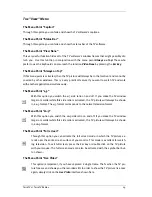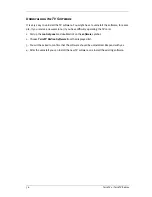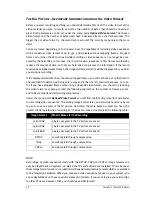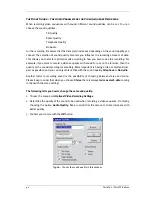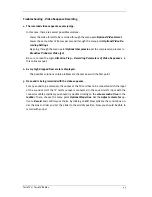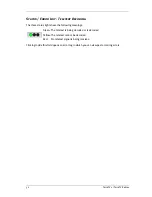
38
/ TerraTV Radio+
The Big Picture – Important Information about the Video Format
Before you start recording anything, you should determine first of all the video format of the
video material you plan to record as well as the number of bytes that should be saved per
pixel. Both parameters can be set under the menu point
Options\Video Format
. The chosen
video format and the number of bytes used have a decisive effect on the data amounts. The
bigger the set video format is, the more data is accrued! The more bytes per pixel, the more
data!
Current systems, depending on their power, have the capability of recording video sequences
with a maximum video format of up to 352 x 288 pixels without dropping frames. Dropped
frames occur when the data accrued while recording a video sequence can no longer be proc-
essed by the hard drive. In this case, the record function jumps over a few frames and thereby
reduces the amount of data, so that your hard drive can process the information. If the record
function has skipped some frames, the dropped-frame statistics will be displayed for you after
you are done recording.
If the displayed statistics show too many dropped frames, you will not have a very fluid result.
The recorded file will end up being very jumpy and is then, for all practical purposes, not use-
ful. If you have dropped frames when using a 384x288 video format, you should try reducing
the video format to 192x144 or read the following segment on the number of frames per sec-
ond to be recorded and determining compression!
Under the menu point
Options\Video Format
you will find another very important parameter
for recording video sequences. The setting Image Format lets you determine how many bytes
to use to save one pixel of the TV picture. As before, the more bytes per pixel you have, the
greater the data yield when recording. For that reason, take a close look at the following table:
Image Format
What it Means for the Recording
32-Bit RGB
4 bytes per pixel in the TV picture are saved
24-Bit RGB
3 bytes per pixel in the TV picture are saved
15-Bit RGB
2 bytes per pixel in the TV picture are saved
BTYUV
Low data yield through compression
YUV9
Low data yield through compression
YUV12
Low data yield through compression
NOTE:
Recordings of video sequences made with the BTYUV, YUV9 and YUV12 image formats can
only be played back on systems, on which the TV card's drivers are installed. This is because
these image formats work in conjunction with special compression formats which are matched
to the television hardware. When you prepare a video sequence for use on your system, you
can easily fall back on these special compression formats. If you want to give your video clips
to other PC users, however, then you should use a RGB format!






